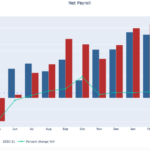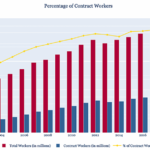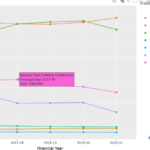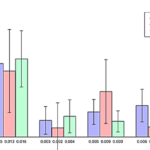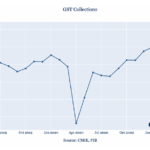MGNREGA: The Rescue Act in Need of Assistance
Explicitly recognizing the right to work as a fundamental right, the United Progressive Alliance (UPA) government introduced a major social safety measure: the Mahatma Gandhi National Rural Employment Guarantee Act (MGNREGA, popularly known as NREGA) in 2005. The Act aims to provide 100 days of employment in a financial year to every rural household for work that involves unskilled manual labor.
Employment is to be provided to an applicant within 5 kms of his/her residence at stipulated minimum wages. While the main aim of the policy is to provide gainful productive employment, work done under MGNREGA has led to the creation of assets in rural India in the form of roads, canals, ponds, or wells.
Over the last 16 years, MGNREGA has ended up being the Indian government’s flagship welfare program. Figure 1 shows us the Budgetary Estimates for various schemes under the Ministry of Rural Development in the years 2020-21 and 2021-22. We can see that MGNREGA makes 51 and 56 percent of entire budgetary estimates in 2020-21 and 2021-22 respectively.
Figure 1
Source: Thirteenth Report of Parliamentary Standing Committee on Rural Development
We should note that this was started as a workfare program that pays a worker minimum wage for unskilled manual work. This makes it a self-targeting or demand-driven program as it helps the poor who have few alternatives with low paying work. Thus, it provides a social security net and aids poverty alleviation.
Its importance as a vital social safety net was brought home acutely during the economic hardship in the wake of the coronavirus pandemic.
On March 24, 2020, the Government of India imposed a sudden and strict lockdown of the economy, which was among the most stringent in the world. As the economy ground to halt in April and May 2020, India witnessed massive movement of its circular migrants from destination states like Punjab, Haryana, Delhi, Gujarat, and Maharashtra to their home states e.g. Uttar Pradesh, Bihar, and Jharkhand. As migrants returned to their homes, due to economic distress and lack of economic activity in urban centres, MGNREGA’s role as an economic cushion and succor became even more critical.
In this piece, we take a deeper dive into key dimensions of MGNREGA to understand how the scheme has fared in the country since 2014. This data narrative uses official data from the MGNREGA website to analyze trends in various aspects of NREGA over a longer period.
NREGA over the years
1. Job cards
Figure 2 looks at the yearly change in number of job cards issued to households between 2015-16 and 2020-21. It shows us the number of job cards deleted or added, and the net change in the number of job cards in each year. We see that between 2016-17 and 2019-20 the number of new job cards added each year was on a declining trend, but since 2017-18, there was a net increase in the number of job cards as there were fewer deletions than additions. From a net decline of 2.4 million job cards in 2016-17, the next year (2017-18) saw a net increase of 1.8 million job cards. It is worth noting that the Indian economy had to deal with a previous episode of a sudden negative shock in the form of demonetization, which rendered INR 500 and 1000 currency notes redundant from November 8, 2016 onwards. This had a massive negative impact on micro, small and medium enterprises which are heavily cash-dependent, which may have resulted in net additions to job card numbers in the next year as a result of distress-driven demand for NREGA work. We see that more than 17.5 million new job cards were added in the year of the pandemic, 2020-21, a growth of 182 percent over 2019-20, reflecting economic distress that drove up the demand for NREGA work.
Figure 2
Thus, Figure 2 shows that economic distress is followed by an increase in NREGA job cards, underscoring the importance of the program as a safety net.
We should note that the number of job cards reflects a combination of factors: individual willingness for NREGA work, which would go up in times of distress. However, the demand for NREGA work could be negatively impacted by irregular wage payments which would make it unreliable as a safety net. There are also accounts of delays in the issue of job cards. These are factors that lower the efficacy of the scheme as a safety net.
Figure 3 shows the cumulative number of households (HH) that were issued MGNREGA job cards every year between 2016-17 and 2021-22. We find that while the cumulative number of HH issued MGNREGA job cards had declined by 10.8 percent in 2018-19, it increased by 5.8 percent in 2019-20 and by 14 percent in 2020-21.
The decline in the number of HH that were issued MGNREGA job cards in 2018-19 is surprising given India’s poor economic performance in the period. However, delays in processing of NREGA wages might have contributed to this decline. In January 2019, the Union government was forced to explain the reasons why these wages were delayed. The staggering jump in 2020-21 is obviously explained by the coronavirus pandemic’s impact on the Indian economy and job market, but it is the growth in the year 2019-20 (before the pandemic) which is noteworthy. It reflects the slowdown in the Indian economy even before the pandemic had struck.
Figure 3
2. Caste and Gender break-up of NREGA beneficiaries
Figure 4 shows the caste break-up of MGNREGA job card beneficiaries. In 2015-16, Scheduled Caste (SC) households comprised 21.3 percent of all households that were issued job cards. Scheduled Tribes (ST) households constituted 13.5 percent, while “Others” (non-SC-ST households) comprised the remaining 65.2 percent. However, we find that since 2016-17, the percentage of “Others” has steadily climbed up, while that of SC and ST HH has gone down. In 2021-22, “Others” make up 67.2 percent of all HH that have been issued job cards, while SC and ST HH have come down to 19.7 and 13.1 percent respectively. This is surprising because Dalit-Adivasi households tend to be disproportionately landless laborers and are therefore more likely to demand NREGA work.
Figure 4
Figure 5 shows that women comprise a smaller percentage of registered workers, but a higher percentage of active workers. Registered workers are workers who have been issued job cards while active workers are those workers who have been provided employment in that financial year. While women consistently make up for 45.7 percent of the registered workers every year, they are nearly 50 percent of all active workers.
MGNREGA data also shows that women consistently have a higher percentage of all persondays of work than men. Their share is consistently more than 53 percent between 2015-16 and 2021-22 and in some years even went up to 56 percent. Post-Covid, the share of women fell in the years 2020-21 and 2021-22, reflecting the continued distress in the rural labor market whereby men have increased their participation the public works employment scheme.
Figure 5
3. Wages
According to the Ministry for Rural Development, “wage rates for workers under MGNREGA, 2005 are notified and revised annually based on Consumer Price Index-Agricultural Laborers (CPI-AL) by the Central Government in accordance with the provisions of MGNREGA.” The state-wise minimum MGNREGA wages are announced by the Ministry of Rural Development every year and effective from April 1.
Figure 6 shows the national average daily wage paid for MGNREGA work. From INR 153.67 in 2015-16, it has increased to INR 207.20 in 2021-22. The highest daily wages for MGNREGA work are paid in the states of Haryana, Goa, and Kerala. The average daily wage in Haryana in 2020-21 was INR 308, while it was INR 294 in Kerala. Kerala has the highest, while Haryana has the second highest minimum wage for agricultural labor in India. The national MGNREGA average wage in 2020-21 was INR 201.42.
Figure 6
To check average wage in a state in a particular year, use the slider in the top right corner to select the year and hover over the state to see the data
4. New Works under NREGA
MGNREGA saw a 24 percent growth in new works started in the year 2020-21 (year of the pandemic) over 2019-20. 10.42 million new works were started in 2020-21 across India compared to 8.39 million in 2019-20. Among large states, the highest growth in new works started was seen in Karnataka (180 percent), and Uttar Pradesh (167 percent).
Figure 7 shows the number of ongoing MGNREGA works across the country. We can see that while the number of ongoing works had declined after 2017-18, these rose sharply in 2020-21, registering a growth of 21 percent over 2019-20.
Figure 7
5. Employment provided under MGNREGA
According to the Ministry of Rural Development, “A Job Card is an entitlement card issued to every household whose any adult member has demanded employment under Mahatma Gandhi NREGA and has shown willingness to do casual manual labor. Every Job Card holder is entitled to 100 days of casual manual labor.”
A job card is valid for five years after which it can be renewed upon verification. A job card can have the names of more than one adult member of the household to which it is issued, and each individual is entitled to receive work under the scheme.
Figure 8 shows the actual employment provided under MGNREGA to households or persons and the total number of persondays of work provided. Persondays is defined as the number of persons working per day multiplied by the number of days worked. This number was fairly flat between 2015-16 and 2019-20. The number of HH and persons provided employment under MGNREGA saw a sharp jump in 2020-21 over 2019-20. In 2020-21, 61.34 million households, and 92.34 million persons were provided employment. The number of persondays of work provided in the year was the highest since 2015-16 at 3097 million.
In principle, job cards would be an indicator of demand for NREGA work and persondays would be an indicator of supply. However, the standing committee on rural development noted delays in release of funds to this scheme. It noted “At the time of economic distress caused due to Covid-19 pandemic, there was an increase in the demand for work under MGNREGA. However, inordinate delay in the release of funds for skilled/semi-skilled workers under MGNREGA is a huge discouraging aspect and does not go in consonance with the underlying spirit of the scheme”.
This may have affected the number of job cards as well.
Figure 8
Households saw a 49 percent growth in employment in 2020-21 under MGNREGA over 2019-20, while persons saw a growth of 54 percent in the same period. Persondays saw a growth of 57 percent in 2020-21 over 2019-20, as noted in Figure 9.
Figure 9
Figure 10 looks at age-group-wise employment percentage across years. The percentage is calculated by dividing the number of workers employed by the number of registered workers in each age-group every year between 2015-16 and 2021-22. We observe a steady increase in employment percentage of 18–30-year-olds between 2015-16 and 2018-19. We then see a sharp increase in the employment percentage of this group in 2020-21. While employment percentage increases for all age groups in 2020-21, we see the highest increase in the youngest age group. Their employment increases from 20.4 percent in 2019-20 to 37.3 percent in 2020-21. This also shows the important role played by MGNREGA in providing a fallback option to workers in a year of sharp economic downturn. In fact, this shows that it’s the youth who either could not enter the labor market during the pandemic induced economic slowdown or suffered a higher proportion of job losses. This is in line with our previous analysis of EPFO data which showed that the pandemic hurt younger workforce disproportionately.
Figure 10
6. The 100-day promise?
While MGNREGA promises 100 days of employment to each household, data tells us that the reality is vastly different. Figure 11 shows us the average number of days employment was provided to each registered person or household and the average daily wage in that year in each state. The average employment provided to registered persons is calculated by dividing total persondays of employment provided in a particular year by the number of registered persons for that year. Similarly, the average employment provided to registered HH is calculated by dividing total number of persondays of employment in a year by the total number of registered HH in that year.
We find that between 2015-16 and 2020-21, the highest average employment provided per registered person in the country was 12 days in the year of the pandemic, 2020-21. The lowest average employment during this period was 8 days in 2015-16. Looking across states, we find that among large states, the highest average employment per registered person was provided in Chhattisgarh and Jammu and Kashmir in 2020-21 with 18 days of employment. This number is higher in smaller states in the north-east, with Mizoram providing 86 days of employment per registered person in 2020-21, while Nagaland saw 24 days of average employment per person in the same year.
If we look at the average employment per registered HH, we find the situation to be as bad. Between 2015-16 and 2020-21, the highest average employment per registered HH was seen in 2020-21 at 22 days (national average). This is much lower than the promise of 100 days of employment per HH. Among large states, the highest average employment per registered HH in 2020-21 was provided by Chhattisgarh at 43 days. Madhya Pradesh saw an average of 39 days. In the same year, Uttar Pradesh, and Bihar saw an average of only 18 days and 11 days respectively. Among smaller states, Mizoram saw the highest average employment per registered HH at 95 days in 2020-21.
2020-21 saw only 4.1 percent of registered families find 100 days of employment under MGNREGA across the country. This was the highest percentage since 2015-16. Among large states, Chhattisgarh, at 14 percent, saw the highest percentage of families receive 100 days of work in 2020-21. Uttar Pradesh stood at 4 percent, while Bihar saw only 0.17 percent families find 100 days of work in 2020-21.
Figure 11
To check average employment per registered person or household in a state in a particular year, use the slider in the top right corner to select the year and hover over the state to see the data
7. Expenditure on NREGA
The standing committee on rural development’s report notes the Department of Rural Development’s (DoRD) answer on funds for MGNREGA in 2020-21. According to the department, “The budgetary estimate (BE) of FY 2020-21 for Mahatma Gandhi NREGS is Rs. 61,500 cr. An additional fund of Rs.50,000 cr has been provided under Atma Nirbhar Bharat package for dealing with a reduction in economic activity following lockdown and return of migrants to rural areas. It increases the total allocation to Rs.1,11,500 cr. Out of which, Rs.89,287.63 crore has been utilized till 31.01.2021 (80%).” However, the BE for 2021-22 for MGNREGA is Rs 73,000 cr which is much lower than the Rs 89,287.23 crore which had already been utilized in only 10 months in 2020-21.
The report questions this small increase in BE for 2020-21, to which the DoRD replied that, “At the time of BE for 2021-22, it has been taken into consideration that financial year 2021-22 might be a normal year.” However, India saw a devastating second wave of the pandemic in April and May 2021 which puts this assumption under stress.
The Standing Committee’s report notes the delay in release of funds for skilled/semi-skilled workers under MGNREGA, especially in the times of a pandemic.
“At the time of economic distress caused due to Covid-19 pandemic in particular, there was an increase in the demand of work under MGNREGA. However, inordinate delay in the release of funds for skilled/semi-skilled workers under MGNREGA is a huge discouraging aspect and does not go in consonance with the underlying spirit of the scheme. It has been noticed that due to such contingency, skilled/semi-skilled workers get discouraged to take up the works under MGNREGA for which not only the works suffer but also the idea behind providing works to the rural population get defeated. Therefore, the Committee is of the view that the Department should appropriately modify its approach and ensure that the 40 percent part of the fund also reaches on time so that the wages are paid on time and the works get completed too,” it suggested.
The report also makes a case for uniform wage under MGNREGA for both men and women across states. “In view of Article 39 of the Constitution and to have parity in wages, the Committee strongly recommend that MGNREGA beneficiaries must be paid wages without any disparity in order to bring equality in wages under MGNREGA across all States/UTs urgently,” it says.
Conclusion
Every Indian citizen has the right to employment as a fundamental right. As we have highlighted above, MGNREGA plays a key role in fulfilling that right, even when it falls short of its 100-day promise. Especially during episodes of acute economic distress (e.g., demonetization or Covid-19 induced economic slowdown), rural employment guarantee has played a vital role. In the post-Covid slowdown, youth suffered disproportionately more in terms of loss of employment, and we see that reflected in NREGA data, as the age group 18-30 has registered the highest increase in NREGA employment. As our earlier analysis of employment shows, employment growth had been faltering even before the pandemic hit. This has resulted in a situation that often leaves NREGA as the only hope of gainful employment.
The demand for NREGA work is clear, however, our analysis above indicates a mismatch between demand and supply. It is evident that the need of the hour is to increase supply of NREGA work, as well as remove bottlenecks that prevent issuing new job cards, delay wage payments or slow down the start of new work.
The demand for employment guarantee in rural areas underscores the need for similar workfare programs in urban India as well. Rising demand for unskilled work at low wages under MGNREGA also highlights the lack of employment opportunities in the Indian economy. Finally, the safety net of MGNREGA should not be seen as an alternative to creating decent, good quality jobs, which ought to be the priority for policymakers.
If you wish to republish this article or use an extract or chart, please read CEDA’s republishing guidelines.
